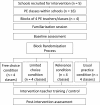A cluster-randomized controlled trial of strategies to increase adolescents' physical activity and motivation during physical education lessons: the Motivating Active Learning in Physical Education (MALP) trial
- PMID: 23025261
- PMCID: PMC3524026
- DOI: 10.1186/1471-2458-12-834
A cluster-randomized controlled trial of strategies to increase adolescents' physical activity and motivation during physical education lessons: the Motivating Active Learning in Physical Education (MALP) trial
Abstract
Background: The physical activity (PA) levels of many children and adolescents in Australia are currently insufficient to promote health benefits. Physical education (PE) programs aim to promote PA and reach nearly all school-aged children, but PA levels within PE lessons are often low. PE teachers may influence children's motivation to be physically active in PE lessons, but little is known about teacher strategies that effectively motivate children to participate in PA, and few intervention studies have examined motivational strategies in PE. The purpose of this study was to compare the effect of three motivational strategies, each based on Self-Determination Theory (SDT), on PA levels, and their hypothesized antecedents, during year 8 PE lessons.
Methods/design: This study employed a cluster-randomized controlled trial design. Following a familiarization session, PA levels and hypothesized PA antecedents were measured during a baseline lesson and a post-intervention or control lesson. Teachers (n = 16) and their classes from five secondary schools in Sydney, Australia were randomly assigned into four blocks and instructed to provide one of four 20-min lesson teaching strategy conditions: (1) explaining the relevance of activities; (2) providing choice from PA options selected by the teacher; (3) providing equipment and free choice of activities; or (4) usual practice. The primary outcomes were lesson time spent in moderate-to-vigorous PA, and motivation towards the lesson. Secondary outcomes were perceptions of teacher behavior, psychological needs satisfaction, and lesson time spent in sedentary behavior. PA and sedentary behavior were measured during baseline and post-intervention lessons with waist-mounted Actigraph GT3X accelerometers. Teacher behavior, psychological needs satisfaction, and motivation were assessed via questionnaires at the end of each lesson. Linear mixed-model analyses will be run on all outcomes, with students nested within teachers as a random effect.
Discussion: Study findings will inform the development of effective SDT-based teaching strategy interventions to enhance students' psychological needs satisfaction, motivation, and PA levels. More effective teaching strategies may be identified that are capable of improving adolescents' PA levels, and thereby provide beneficial population health outcomes.
Trial registration: This trial is registered with Current Controlled Trials and is traceable as ISRCTN07038258.
Figures
References
-
- US Department of Health and Human Services (USDHHS) Physical Activity Guidelines Advisory Committee Report. US Department of Health and Human Services, Washington; 2008.
-
- Department of Health & Ageing. 2007 Australian National Children’s Nutrition and Physical Activity Survey - Main Findings. Australian Government Department of Health & Ageing, Canberra; 2008.
-
- Lubans DR, Morgan PJ, Aguiar E, Callister R. Randomized controlled trial of the Physical Activity Leaders (PALs) program for low-active adolescent boys from disadvantaged secondary schools. Prev Med. 2011;52:239–246. - PubMed
Publication types
MeSH terms
Associated data
LinkOut - more resources
Full Text Sources
Medical



